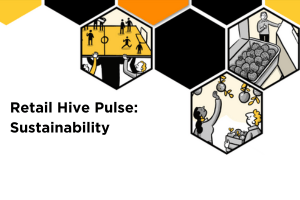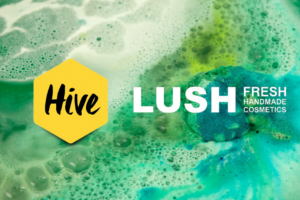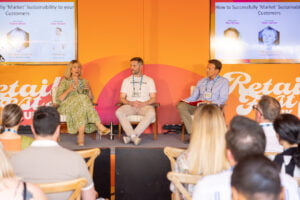Hive Heroes:
For Ann Summers, transport and distribution only account for around 3% of their carbon footprint, while 86% stems from products, particularly the manufacturing process.
They’re three years into a 10-year journey with science-based targets, with a definite reduction in Scope 1 and Scope 2 emissions, and are planning for a 55% reduction in Scope 3 emissions by the end of 2031.
Dan Pass
Head of Logistics

Dan caught up with Frances at The Retail Hive, discussing Ann Summers’ sustainable progress so far. View the highlights below…
We’re treading carefully: missteps tend to lead to accusations of greenwashing, but we’re focussing on putting in place really robust and clear processes throughout every step of our supply chain.”
Is sustainability becoming a higher priority for your company and if so, what are the main drivers behind that?
Absolutely, sustainability has always been a priority for us, it’s in our DNA to care about people and the planet. Regulatory compliance and industry standards, such as the net zero targets set by the British Retail Consortium and science-based targets, have been useful tools and are helping to unite retailers towards a common goal.
Internally, we’re intensifying efforts to reduce our carbon footprint across Scope 1, 2, and 3 emissions. This will be our fifth year reporting on Scope 3 emissions, and we have made steady progress year-on-year. We’re finding that our consumers and our colleagues are expecting more of the retail sector and want to make more conscious choices about what they buy and where they work, so it’s vitally important for us to meet their evolving needs.
How are you addressing the risk of greenwashing amid increasing complexity in sustainability reporting?
Navigating the landscape of sustainability reporting comes with its challenges. We’re treading carefully: missteps tend to lead to accusations of greenwashing, but we’re focussing on putting in place really robust and clear processes throughout every step of our supply chain.
We are in full support of greater transparency and verification around sustainability claims, as we recognise how important it is for consumers to be able to make well-informed choices. However, the complexity of data verification and the lack of industry-wide standards can often mean that preparing and validating information can become overly-onerous on small and medium sized businesses, where resource is limited.
We find this complexity is compounded by the fact there are so many methodologies used in carbon reporting, meaning discrepancies come up a lot. Two people might take the same data, but come out with different results. Ensuring transparency and accountability throughout the supply chain can feel like a daunting task, but we can’t let that put us off. We are wholeheartedly committed to our sustainability efforts and continuously improving our practices.
Packaging is often brought up as a go-to when it comes to sustainability. How are you tackling it?
Surprisingly, packaging has a relatively small carbon footprint in our business, but it’s an issue in terms of waste, and particularly for our customers as they experience our packaging first hand and have their own responsibilities to process it. As a result, we’ve made concerted efforts to eliminate plastic from outbound packaging, bringing paper alternatives wherever feasible.
It’s not always easy to find the right solution, particularly in product packaging for lingerie, where we need to protect our product carefully. It’s a balance between environmental goals and practical constraints. So far, we’ve managed to remove approximately 2 million hangers from our supply chain and wherever we can, we’re removing plastic, so things like bra clips have gone, we’ve even reduced the length of our plastic kimbles and the size of our polybags.
It turns out that paper packaging, even when it’s recycled, has a higher carbon footprint than plastic, although obviously it can’t be recycled or composted as easily as paper can, so making the right call can be a challenge. We’re making changes where we can, moving our card swing tags to FSC certified or recycled cardboard and working with suppliers who can recycle a lot of the materials we use. It’s a tricky balancing act and we need to decide if we’re aiming to reduce emissions or reduce waste. To do it all, you might need to end up offsetting one goal against another temporarily until you find the right solution.
How do you manage the carbon footprint within the supply chain, and how does that intersect with other departments?
Although we’re moving products around the world, we actually contribute a surprisingly small amount to Ann Summers’ overall carbon footprint. Transport and distribution only account for around 3% of our footprint, while 86% of our carbon footprint stems from the product itself, and particularly from the manufacturing process. We have a cross-functional team who span the business and have been working with our suppliers to set parameters for them in a code of conduct.
We’re now at a point where we have very tangible relationships with teams in our supplier base and are in the process of mapping out our supply chain beyond tiers 1 and 2 to vastly improve our traceability. We’re lucky not to have a massive product supplier base which means we can stay agile and work in this way. Although our team isn’t huge, we’ve been able to work cleverly to understand the parameters of putting together data on our carbon footprint, automating and improving it so we’re producing more accurate data every year to use as a springboard for effective initiatives.

Some sustainability measures reduce costs too, and those are a no-brainer, but when sustainability significantly increases costs, we have to ensure that what it delivers is a marked improvement environmentally.”
How do you navigate the balance between cost efficiency and sustainability, especially in the face of market pressures?
The current market is definitely tricky when it comes to making decisions on sustainability which don’t also offer a cost saving. A lot of what we’ve been doing—and want to do—in terms of implementing sustainability initiatives, incurs additional costs that we wouldn’t have had to deal with before. Some sustainability measures reduce costs too, and those are a no-brainer, but when sustainability significantly increases costs, we have to ensure that what it delivers is a marked improvement environmentally.
Having said that, there’s a noticeable shift towards prioritising sustainability discussions across the business. We’re three years into a 10-year journey with science-based targets at the moment, with a definite reduction in Scope 1 and Scope 2 emissions, and a plan for a 55% reduction in our Scope 3 emissions by the end of 2031.
In order to implement these targets, we’ve been working on financial modelling. The easiest and most known way to make a change right away is by switching to more recycled fibres throughout our supply chain—from product to packaging. Being able to model future carbon costs helps us work out how and when to make changes in a measured way to our margins while making the most effective impact on our environmental outcomes.
It’s also about working with the right partners and building really strategic partnerships across our supplier base. We have so many common goals, our goal will likely also be our suppliers’ goals, so we want to work with the right people in a really strategic way.
How have your suppliers responded to your sustainability initiatives, and are you finding it challenging to source sustainable solutions?
We are keen to introduce recycled materials. We’re seeing rapid progress being made and relatively little impact operationally. What’s more challenging for us as a business is logistics and final mile solutions, where EVs aren’t always providing what we need. We’re also struggling more with our hard good products, where recycled replacements for silicone and PVC, for example, are often much more carbon intensive.
What would you flag as the most unexpected challenge around your sustainability efforts?
One of our biggest challenges for our business are adult toys. They’re a niche area of sustainability, so not as easy to make material swaps for. Then at the end of life, closing the loop and disposing of those products is more challenging. We’re looking for greater innovation in this sector to help us make meaningful change.
Another challenge we encounter in the supply chain is data management. Collecting, managing, validating, and reporting information consistently across various aspects of our operations presents a huge task. The wider retail industry grapples with similar issues, and it would be useful to understand how others are addressing this challenge too. It’s not something you want to risk getting wrong, because it forms the basis for decision-making and benchmarking.




